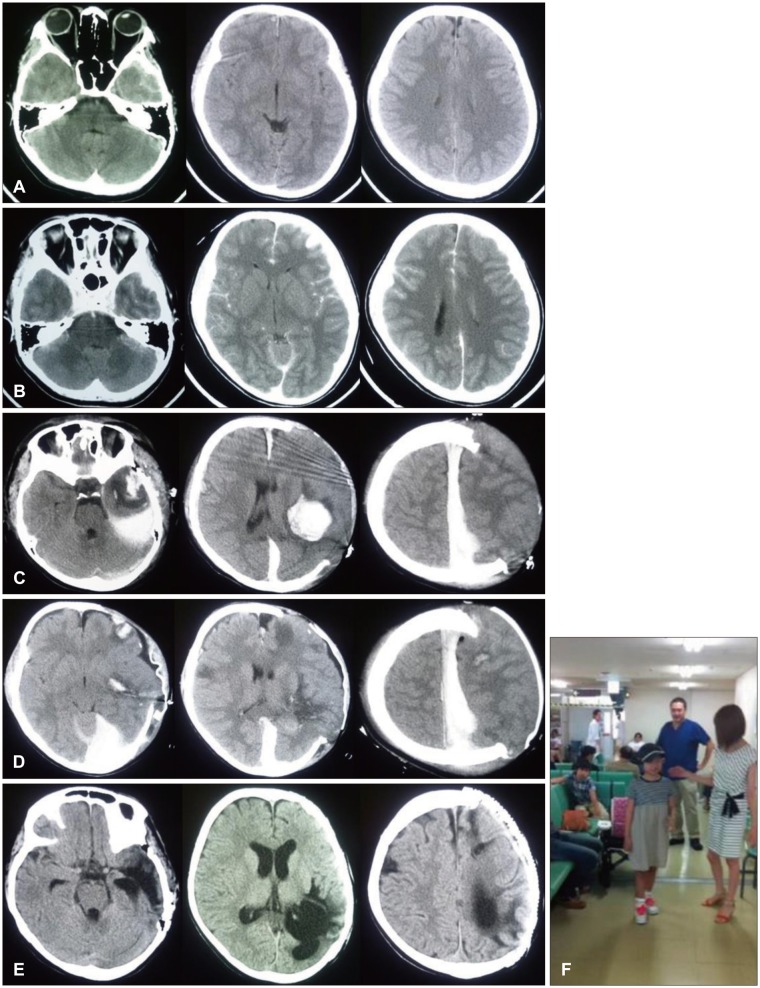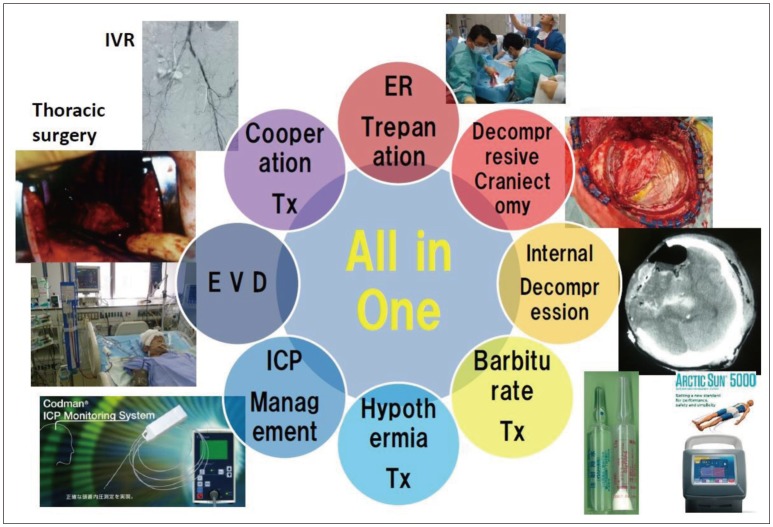1. Andrews BT, Pitts LH. Functional recovery after traumatic transtentorial herniation. Neurosurgery. 1991; 29:227–231. PMID:
1886660.

2. Andrews PJ, Sinclair HL, Rodriguez A, Harris BA, Battison CG, Rhodes JK, et al. Hypothermia for intracranial hypertension after traumatic brain injury. N Engl J Med. 2015; 373:2403–2412. PMID:
26444221.

3. Beck B, Gantner D, Cameron PA, Braaf S, Saxena M, Cooper DJ, et al. Temporal trends in functional outcomes after severe traumatic brain injury: 2006-2015. J Neurotrauma. 2018; 15:1021–1029.

4. Bor-Seng-Shu E, Figueiredo EG, Amorim RL, Teixeira MJ, Valbuza JS, de Oliveira MM, et al. Decompressive craniectomy: a meta-analysis of influences on intracranial pressure and cerebral perfusion pressure in the treatment of traumatic brain injury. J Neurosurg. 2012; 117:589–596. PMID:
22794321.

5. Bullock MR, Chesnut R, Ghajar J, Gordon D, Hartl R, Newell DW, et al. Surgical management of acute subdural hematomas. Neurosurgery. 2006; 58:S16–S24. PMID:
16710968.

6. Busto R, Globus MY, Dietrich WD, Martinez E, Valdés I, Ginsberg MD. Effect of mild hypothermia on ischemia-induced release of neurotransmitters and free fatty acids in rat brain. Stroke. 1989; 20:904–910. PMID:
2568705.

7. Carney N, Totten AM, O'Reilly C, Ullman JS, Hawryluk GW, Bell MJ, et al. Guidelines for the management of severe traumatic brain injury, fourth edition. Neurosurgery. 2017; 80:6–15. PMID:
27654000.

8. Clifton GL, Miller ER, Choi SC, Levin HS, McCauley S, Smith KR Jr, et al. Lack of effect of induction of hypothermia after acute brain injury. N Engl J Med. 2001; 344:556–563. PMID:
11207351.

9. Clifton GL, Valadka A, Zygun D, Coffey CS, Drever P, Fourwinds S, et al. Very early hypothermia induction in patients with severe brain injury (the National Acute Brain Injury Study: Hypothermia II): a randomised trial. Lancet Neurol. 2011; 10:131–139. PMID:
21169065.

10. Cooper DJ, Rosenfeld JV, Murray L, Arabi YM, Davies AR, D'Urso P. Decompressive craniectomy in diffuse traumatic brain injury. N Engl J Med. 2011; 364:1493–1502. PMID:
21434843.

11. Haselsberger K, Pucher R, Auer LM. Prognosis after acute subdural or epidural haemorrhage. Acta Neurochir (Wien). 1988; 90:111–116. PMID:
3354356.

12. Huang AP, Tu YK, Tsai YH, Chen YS, Hong WC, Yang CC, et al. Decompressive craniectomy as the primary surgical intervention for hemorrhagic contusion. J Neurotrauma. 2008; 25:1347–1354. PMID:
19061378.

13. Iida K, Kurisu K, Arita K, Ohtani M. Hyperemia prior to acute brain swelling during rewarming of patients who have been treated with moderate hypothermia for severe head injuries. J Neurosurg. 2003; 98:793–799. PMID:
12691404.

14. Leitgeb J, Mauritz W, Brazinova A, Janciak I, Majdan M, Wilbacher I, et al. Outcome after severe brain trauma due to acute subdural hematoma. J Neurosurg. 2012; 117:324–333. PMID:
22631691.

15. Mahoney BD, Rockswold GL, Ruiz E, Clinton JE. Emergency twist drill trephination. Neurosurgery. 1981; 8:551–554. PMID:
7266793.

16. Matsushima K, Inaba K, Siboni S, Skiada D, Strumwasser AM, Magee GA, et al. Emergent operation for isolated severe traumatic brain injury: Does time matter? J Trauma Acute Care Surg. 2015; 79:838–842. PMID:
26317818.
17. Nakamura T, Miyamoto O, Yamagami S, Hayashida Y, Itano T, Nagao S. Influence of rewarming conditions after hypothermia in gerbils with transient forebrain ischemia. J Neurosurg. 1999; 91:114–120. PMID:
10389889.

18. Olivecrona M, Rodling-Wahlström M, Naredi S, Koskinen LO. Effective ICP reduction by decompressive craniectomy in patients with severe traumatic brain injury treated by an ICP-targeted therapy. J Neurotrauma. 2007; 24:927–935. PMID:
17600510.

19. Onuma T, Kameyama M, Shimosegawa Y, Shiina G. One burr hole surgery in the emergency room for traumatic extracerebral hematoma. Neurotraumatology. 1993; 16:161–166.
20. Park YS, Ishikawa J. Analysis of mild barbiturate-moderate hypothermia therapy on the authors' 152 cases. No Shinkei Geka. 1997; 25:529–535. PMID:
9181590.
21. Park YS, Ishikawa J. Wide craniotomy-small dural incisions and intentionally delayed removal of intracerebral contusional hemorrhage for acute subdural hematoma. No Shinkei Geka. 1997; 25:1081–1089. PMID:
9430142.
22. Park YS, Ishikawa J. Clinical result of moderate hypothermia therapy in patients with ruptured cerebral aneurysm. Jpn J Neurosurg. 1998; 7:71–78.

23. Salottolo K, Carrick M, Levy AS, Morgan BC, Mains CW, Slone DS, et al. Aggressive operative neurosurgical management in patients with extra-axial mass lesion and Glasgow Coma Scale of 3 is associated with survival benefit: A propensity matched analysis. Injury. 2016; 47:70–76. PMID:
26499227.

24. Seelig JM, Becker DP, Miller JD, Greenberg RP, Ward JD, Choi SC. Traumatic acute subdural hematoma: major mortality reduction in comatose patients treated within four hours. N Engl J Med. 1981; 304:1511–1518. PMID:
7231489.
25. Shimoda K, Maeda T, Tado M, Yoshino A, Katayama Y, Bullock MR. Outcome and surgical management for geriatric traumatic brain injury: analysis of 888 cases registered in the Japan Neurotrauma Data Bank. World Neurosurg. 2014; 82:1300–1306. PMID:
25128777.

26. Stein SC, Georgoff P, Meghan S, Mizra K, Sonnad SS. 150 years of treating severe traumatic brain injury: a systematic review of progress in mortality. J Neurotrauma. 2010; 27:1343–1353. PMID:
20392140.

27. Suehiro E, Koizumi H, Kunitsugu I, Fujisawa H, Suzuki M. Survey of brain temperature management in patients with traumatic brain injury in the Japan neurotrauma data bank. J Neurotrauma. 2014; 31:315–320. PMID:
24047191.

28. Tien HC, Jung V, Pinto R, Mainprize T, Scales DC, Rizoli SB. Reducing time-to-treatment decreases mortality of trauma patients with acute subdural hematoma. Ann Surg. 2011; 253:1178–1183. PMID:
21494125.

29. Timofeev I, Czosnyka M, Nortje J, Smielewski P, Kirkpatrick P, Gupta A, et al. Effect of decompressive craniectomy on intracranial pressure and cerebrospinal compensation following traumatic brain injury. J Neurosurg. 2008; 108:66–73. PMID:
18173312.

30. Xu RX, Nakamura T, Nagao S, Miyamoto O, Jin L, Toyoshima T, et al. Specific inhibition of apoptosis after cold-induced brain injury by moderate postinjury hypothermia. Neurosurgery. 1998; 43:107–114. PMID:
9657196.

31. Yager JY, Asselin J. Effect of mild hypothermia on cerebral energy metabolism during the evolution of hypoxic-ischemic brain damage in the immature rat. Stroke. 1996; 27:919–925. PMID:
8623114.

32. Zhang K, Jiang W, Ma T, Wu H. Comparison of early and late decompressive craniectomy on the long-term outcome in patients with moderate and severe traumatic brain injury: a meta-analysis. Br J Neurosurg. 2016; 30:251–257. PMID:
26828333.






 PDF
PDF ePub
ePub Citation
Citation Print
Print




 XML Download
XML Download